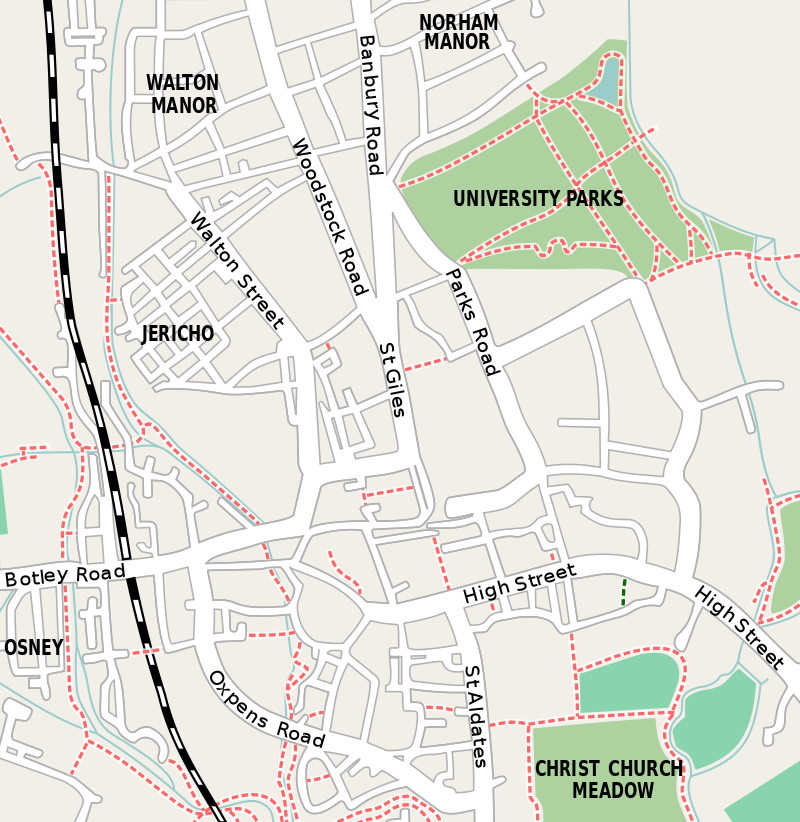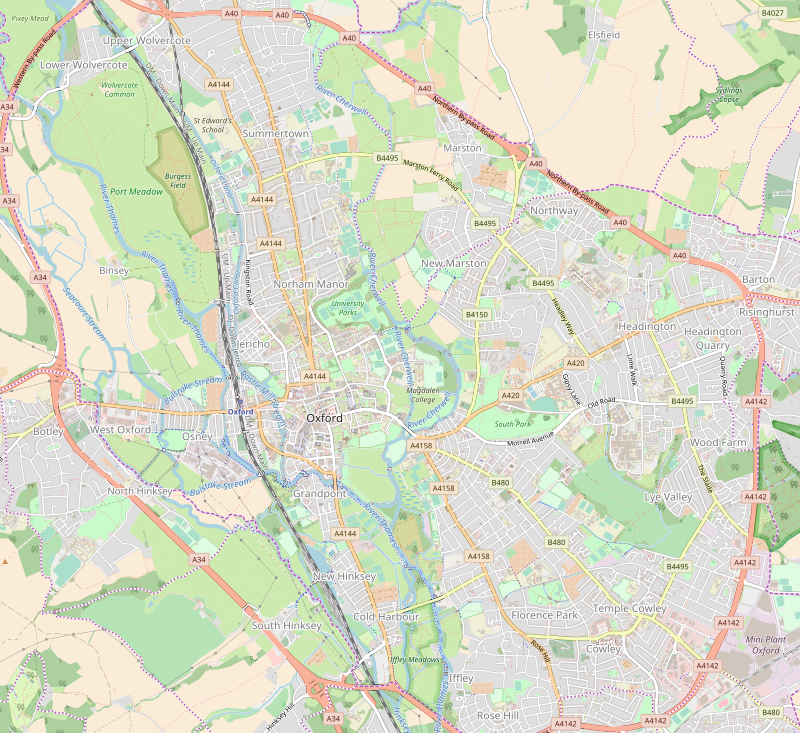The University of Oxford has thirty-nine colleges, and four permanent private halls (PPHs) of religious foundation. Colleges (with the exception of three 'societies of the university') and PPHs are autonomous self-governing corporations within the university. These colleges are not only houses of residence, but have substantial responsibility for teaching undergraduate students. Generally tutorials (one of the main methods of teaching in Oxford) and classes are the responsibility of colleges, while lectures, examinations, laboratories, and the central library are run by the university. Students normally have most of their tutorials in their own college, but often have a couple of modules taught at other colleges or even at faculties and departments. Most colleges take both graduates and undergraduates, but several are for graduates only.

Undergraduate and graduate students may name preferred colleges in their applications. For undergraduate students, an increasing number of departments practise reallocation to ensure that the ratios between potential students and subject places available at each college are as uniform as possible. For the Department of Physics, reallocation is done on a random basis after a shortlist of candidates is drawn upon and before candidates are invited for interviews at the university.[1]
For graduate students, many colleges express a preference for candidates who plan to undertake research in an area of interest of one of its fellows. St Hugh's College, for example, states that it accepts graduate students in most subjects, principally those in the fields of interest of the fellows of the college.[2]
A typical college consists of a hall for dining, a chapel, a library, a college bar, senior, middle (postgraduate), and junior common rooms, rooms for 200–400 undergraduates, and lodgings for the head of the college and other dons. College buildings range from medieval to modern, but most are made up of interlinked quadrangles (courtyards), with a porter's lodge controlling entry from the outside.
2008 saw the first modern merger of colleges, with Green College and Templeton College merging to form Green Templeton College.[3] This reduced the number of colleges of the university from 39 to 38.[4] The number of PPHs also reduced when Greyfriars closed in 2008[5] and when St Benet's Hall closed in 2022.[6] However, with the establishment of Reuben College in 2019, the number of colleges of the university again increased to 39.[7][8] Reuben is the first new Oxbridge college since 1990, when Kellogg College was established.[9]

History
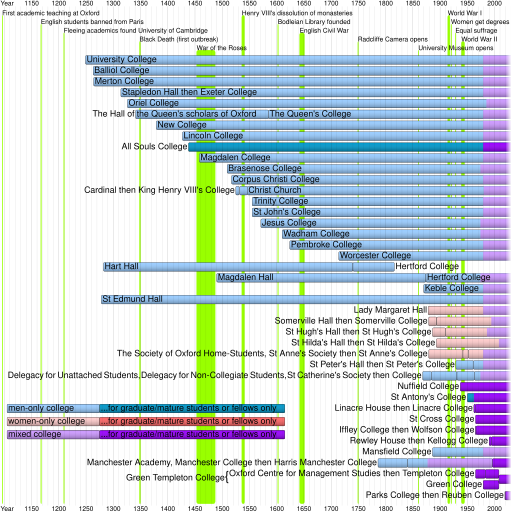
The collegiate system arose because Oxford University came into existence through the gradual agglomeration of numerous independent institutions. Over the centuries several different types of college have emerged and disappeared.
Monastic halls
The first academic houses were monastic halls. Of the dozens established during the 12th–15th centuries, none survived the Reformation. The modern Dominican permanent private hall of Blackfriars (1921) is a descendant of the original (1221), and is sometimes described as heir to the oldest tradition of teaching in Oxford.
Academic halls
As the university took shape, friction between the hundreds of students living where and how they pleased led to a decree that all undergraduates would have to reside in approved halls. What eventually put an end to the medieval halls was the emergence of colleges. Often generously endowed and with permanent teaching staff, the colleges were originally the preserve of graduate students. However, once they began accepting fee-paying undergraduates in the 14th century, the halls' days were numbered. Of the hundreds of Aularian houses (from the Latin for "hall") that sprang up, only St Edmund Hall (c. 1225) remains.
Colleges
The oldest colleges are University College, Balliol, and Merton, established between 1249 and 1264, although there is some dispute over the exact order and precisely when each began teaching. The fourth oldest college is Exeter, founded in 1314, and the fifth is Oriel, founded in 1326.
Women's colleges
Women entered the university in 1879, with the opening of Lady Margaret Hall and Somerville College, becoming members of the University (and thus eligible to receive degrees) in 1920. Other women's colleges before integration were St Anne's, St Hilda's and St Hugh's. In 1974 the first men's colleges to admit women were Brasenose, Hertford, Jesus, St Catherine's and Wadham.[10] By 2008 all colleges had become co-residential, although one of the Permanent Private Halls, St Benet's Hall, did not start to admit postgraduate women until Michaelmas term 2014 and women undergraduates until Michaelmas 2016.
Postgraduate and mature colleges
Some colleges, such as Kellogg, Linacre, Nuffield, St Antony's, St Cross and Wolfson only admit postgraduate students. All Souls admits only fellows. Harris Manchester is intended for "mature students" with a minimum age of 21.[11] The newest college of the University, Reuben College, was established in 2019 as graduate-only, enrolling its first students in 2021 using the premises of the Radcliffe Science Library.[12]
Societies
Kellogg, Reuben and St Cross are the only Oxford colleges without a royal charter. They are officially societies of the university rather than independent colleges[13] and are considered departments of the university for accounting purposes.[14]
Private halls
The Oxford University Act 1854 and the university statute De aulis privatis (On private Halls) of 1855, allowed any Master of Arts aged at least 28 years to open a private hall after obtaining a licence to do so.[15] One such was Charsley's Hall.[16]
Permanent private halls
The Universities Tests Act 1871 opened all university degrees and positions to men who were not members of the Church of England (subject to safeguards for religious instruction and worship), which made it possible for Catholics and Non-conformists to open private halls. The first Catholic private halls were Clarke's Hall (now Campion Hall), opened by the Jesuit Order in 1896 and Hunter Blair's Hall (later St Benet's Hall) opened by the Benedictine Order in 1899.[17][18] In 1918 the university passed a statute to allow private halls which were not run for profit to become permanent private halls and the two halls took their current names.[17]
Map
| Map of the University of Oxford | |||||||||||
|---|---|---|---|---|---|---|---|---|---|---|---|
| |||||||||||
List of colleges
| Name | Latin name | Year of Foundation | Sister college at Cambridge | Total assets[19] | Financial endowment[19] | Assets per student | ||||||
|---|---|---|---|---|---|---|---|---|---|---|---|---|
 All Souls College All Souls College | Collegium Omnium Animarum Fidelium Defunctorum de Oxonia | 1438 | Trinity Hall | £546,604,000[21] | £501,226,000[21] | 0 | 9 | 0 | 56 | 44 | 9 | £51,711,000 |
 Balliol College Balliol College | 1263 | St John's College | £147,546,000[22] | £123,435,000[22] | 385 | 343 | 1 | 60 | 40 | 729 | £202,000 | |
 Brasenose College Brasenose College | 1509 | Gonville and Caius College | £179,827,000[23] | £151,293,000[23] | 360 | 234 | 3 | 52 | 48 | 597 | £301,000 | |
 Christ Church Christ Church | 1546 | Trinity College | £772,200,000[24] | £769,800,000[24] | 442 | 203 | 0 | 58 | 42 | 645 | £1,197,000 | |
 Corpus Christi College Corpus Christi College | 1517 | Corpus Christi College | £191,539,000[25] | £166,841,000[25] | 258 | 98 | 2 | 59 | 41 | 358 | £535,000 | |
 Exeter College Exeter College | 1314 | Emmanuel College | £130,995,000[26] | £74,876,000[26] | 343 | 233 | 26 | 50 | 50 | 602 | £218,000 | |
 Green Templeton College Green Templeton College | 2008 | St Edmund's College | £102,808,000[27] | £1,143,000[27] | 90 | 439 | 0 | 57 | 43 | 529 | £194,000 | |
 Harris Manchester College Harris Manchester College | 1786 College: 1996 | Homerton College | £40,301,000[28] | £14,371,000[28] | 115 | 150 | 0 | 49 | 51 | 265 | £152,000 | |
 Hertford College Hertford College | 1282 College: 1740 | None | £79,183,000[29] | £60,552,000[29] | 410 | 236 | 31 | 49 | 51 | 677 | £117,000 | |
 Jesus College Jesus College | 1571 | Jesus College | £308,251,000[30] | £259,938,000[30] | 358 | 189 | 1 | 53 | 47 | 548 | £562,501 | |
 Keble College Keble College | 1870 | Selwyn College | £128,578,000[31] | £50,313,000[31] | 422 | 369 | 4 | 60 | 40 | 795 | £162,000 | |
 Kellogg College Kellogg College | 1990 Renamed: 1994 | None | —[note 1] | —[note 1] | 0 | 1155 | 0 | 62 | 38 | 1155 | N/A | |
 Lady Margaret Hall Lady Margaret Hall | 1878 | Newnham College | £64,477,000[32] | £36,279,000[32] | 405 | 212 | 24 | 47 | 53 | 641 | £101,000 | |
 Linacre College Linacre College | 1962 | Hughes Hall | £43,288,000[33] | £27,854,000[33] | 0 | 587 | 0 | 52 | 48 | 587 | £74,000 | |
 Lincoln College Lincoln College | 1427 | Downing College | £161,414,000[34] | £124,437,000[34] | 312 | 302 | 3 | 51 | 49 | 617 | £262,000 | |
 Magdalen College Magdalen College | 1458 | Magdalene College | £942,327,000[35] | £710,786,000[35] | 390 | 178 | 7 | 59 | 41 | 575 | £1,639,000 | |
 Mansfield College Mansfield College | 1886 College: 1995 | Homerton College | £30,307,000[36] | £14,627,000[36] | 239 | 173 | 40 | 55 | 45 | 452 | £67,000 | |
 Merton College Merton College | 1264 | Peterhouse | £298,875,000[37] | £274,412,000[37] | 302 | 232 | 2 | 58 | 42 | 536 | £558,000 | |
 New College New College | 1379 | King's College | £363,303,000[38] | £303,324,000[38] | 418 | 295 | 10 | 55 | 45 | 723 | £502,000 | |
 Nuffield College Nuffield College | 1937 | None | £263,017,000[39] | £239,159,000[39] | 0 | 95 | 0 | 54 | 46 | 95 | £2,769,000 | |
 Oriel College Oriel College | Collegium Orielense | 1326 | Clare College | £105,618,000[40] | £86,524,000[40] | 323 | 200 | 5 | 54 | 46 | 528 | £200,000 |
 Pembroke College Pembroke College | 1624 | Queens' College | £87,094,000[41] | £58,870,000[41] | 378 | 220 | 29 | 51 | 49 | 627 | £139,000 | |
 The Queen's College The Queen's College | 1341 | Pembroke College | £426,250,000[42] | £327,789,000[42] | 336 | 177 | 1 | 51 | 49 | 514 | £829,000 | |
 Reuben College Reuben College | 2019 Renamed: 2020 | None | —[note 1] | —[note 1] | 0 | 0 | 0 | 0 | 0 | 0 | N/A | |
 St Anne's College St Anne's College | 1879 College: 1952 | Murray Edwards College | £66,634,000[43] | £40,574,000[43] | 439 | 352 | 37 | 50 | 50 | 828 | £80,000 | |
 St Antony's College St Antony's College | 1950 College: 1963 | Wolfson College | £72,393,000[44] | £44,741,000[44] | 0 | 443 | 0 | 49 | 51 | 443 | £163,000 | |
 St Catherine's College St Catherine's College | 1868 College: 1962 | Robinson College | £142,129,000[45] | £104,305,000[45] | 505 | 428 | 50 | 55 | 45 | 983 | £125,000 | |
 St Cross College St Cross College | 1965 | Clare Hall | —[note 1] | —[note 1] | 0 | 545 | 0 | 55 | 45 | 545 | N/A | |
 St Edmund Hall St Edmund Hall | 1278 College: 1957 | Fitzwilliam College | £87,027,000[46] | £62,771,000[46] | 396 | 296 | 40 | 57 | 43 | 732 | £119,000 | |
 St Hilda's College St Hilda's College | 1893 | None | £119,647,000[47] | £56,592,000[47] | 399 | 183 | 0 | 49 | 51 | 582 | £206,000 | |
 St Hugh's College St Hugh's College | 1886 | Clare College | £69,374,000[48] | £34,934,000[48] | 425 | 366 | 1 | 56 | 44 | 792 | £88,000 | |
 St John's College St John's College | 1555 | Sidney Sussex College | £790,693,000[49] | £712,228,000[49] | 395 | 236 | 3 | 50 | 50 | 634 | £1,247,000 | |
 St Peter's College St Peter's College | 1929 College: 1961 | None | £78,172,000[50] | £47,030,000[50] | 356 | 215 | 21 | 54 | 46 | 592 | £132,000 | |
 Somerville College Somerville College | 1879 | Girton College | £223,804,000[51] | £83,663,000[51] | 425 | 209 | 0 | 50 | 50 | 634 | £353,000 | |
 Trinity College Trinity College | 1555 | Churchill College | £193,684,000[52] | £164,267,000[52] | 299 | 135 | 0 | 54 | 46 | 434 | £446,000 | |
 University College University College | 1249 | Trinity Hall | £209,052,000[53] | £125,489,000[53] | 394 | 224 | 0 | 59 | 41 | 618 | £338,000 | |
 Wadham College Wadham College | 1610 | Christ's College | £142,812,000[54] | £105,237,000[54] | 466 | 208 | 30 | 51 | 49 | 704 | £203,000 | |
 Wolfson College Wolfson College | 1966 College: 1981 | Darwin College | £95,187,000[55] | £60,395,000[55] | 0 | 581 | 0 | 52 | 48 | 581 | £141,000 | |
 Worcester College Worcester College | 1714 | St Catharine's College | £87,218,000[56] | £48,324,000[56] | 438 | 179 | 30 | 50 | 50 | 647 | £135,000 | |
| Total | £6,558,565,000[57] | £5,063,168,000[57] | 11,223 | 10,839 | 401 | 54 | 46 | 22,984 | £285,000 |
List of permanent private halls
| U=Undergraduates • P=Postgraduates • V=Visiting students • M=Male students • F=Female students • T=Total students | |||||||||||||
|---|---|---|---|---|---|---|---|---|---|---|---|---|---|
| Name | Latin name | Foundation | Sister hall at Cambridge | Religious affiliation | Total assets | Financial endowment | U [20] | P [20] | V [20] | M% [20] | F% [20] | T [20] | Assets per student |
 Blackfriars Hall Blackfriars Hall | 1221 Refounded: 1921 PPH 1994 | None | Catholic (Dominican) | —[note 1] | —[note 1] | 3 | 21 | 11 | 57 | 43 | 44 | — | |
 Campion Hall Campion Hall | 1896 | None | Catholic (Jesuit) | —[note 2] | —[note 2] | 0 | 12 | 0 | 100 | 0 | 12 | — | |
 Regent's Park College Regent's Park College | Collegium de Principis Cum Regentis Paradiso | 1752 Move to Oxford: 1927 PPH: 1957 | Lucy Cavendish College | Baptist | £29,024,000[58] | £7,820,000[58] | 155 | 118 | 17 | 48 | 52 | 290 | £100,083 |
 Wycliffe Hall Wycliffe Hall | Aula Wiclefi | 1877 | Ridley Hall | Anglican | £9,364,000[59] | £560,000[59] | 65 | 40 | 53 | 51 | 49 | 158 | £59,000 |
| Total | £25,860,000 | £4,080,000 | 270 | 247 | 78 | 53 | 47 | 517 | £50,000 | ||||
College and permanent private hall arms and colours
Each college and permanent private hall has its own arms, although in some cases these were assumed rather than granted by the College of Arms. Under King Henry VIII Oxford colleges were granted exemption from having their arms granted by the College of Arms; and some, like Lady Margaret Hall, have chosen to take advantage of this exemption, whilst others, such as Oriel, despite having used the arms for many centuries, have recently elected to have the arms granted officially. The blazons below are taken from the Oxford University Calendar[60] unless otherwise indicated. Shields are emblazoned as commonly drawn, and notable inconsistencies between blazons and emblazons (the shields as drawn) are indicated.
Each college also has its own colours used on items such as scarves and rowing blades.
| College | Arms | Blazon | Scarf | Blades |
|---|---|---|---|---|
| All Souls College |  | Or, a chevron between three cinquefoils gules. | ||
| Balliol College | 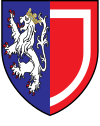 | Azure a lion rampant argent, crowned or, impaling gules, an orle argent. |  | |
| Brasenose College |  | Tierced in pale: (1) Argent, a chevron sable between three roses gules seeded or, barbed vert (for Smyth); (2) or, an escutcheon of the arms of the See of Lincoln (gules, two lions of England in pale or, on a chief azure Our Lady crowned seated on a tombstone issuant from the chief, in her dexter arm the Infant Jesus, in her sinister arm a sceptre, all or), ensigned with a mitre proper; (3) quarterly, first and fourth argent, a chevron between three bugle-horns stringed sable; second and third argent, a chevron between three crosses crosslet sable (for Sutton).[a] |  | |
| Christ Church | 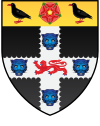 | Sable, on a cross engrailed argent, a lion passant gules between four leopards' faces azure, on a chief or a rose of the third, seeded or, barbed vert, between two Cornish choughs proper. |  | |
| Corpus Christi College | 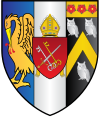 | Tierced per pale: (1) Azure, a pelican with wings endorsed vulning herself or; (2) Argent, thereon an escutcheon charged with the arms of the See of Winchester (i.e. gules, two keys addorsed in bend, the uppermost or, the other argent, a sword interposed between them in bend sinister of the third, pommel and hilt gold; the escutcheon ensigned with a mitre of the last); (3) Sable, a chevron or between three owls argent, on a chief of the second as many roses gules, seeded of the second, barbed vert. |  | |
| Exeter College | 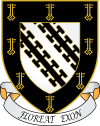 | Argent, two bends nebuly within a bordure sable charged with eight pairs of keys, addorsed and interlaced in the rings, the wards upwards, or. |  | |
| Green Templeton College | 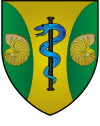 | Or between two flaunches vert on each a nautilus shell the aperture outwards or a rod of Aesculapius sable the serpent azure. |  | |
| Harris Manchester College | 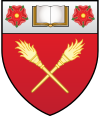 | Gules, two Torches inflamed in saltire proper; on a Chief Argent, between Two Roses of a field barbed and seeded an open Book also proper. | ||
| Hertford College | 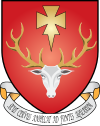 | Gules, a stag's head caboshed argent, attired, and between the attires a cross patty fitchy at the foot, or. |  | |
| Jesus College |  | Vert, three stags trippant argent attired or. |  | |
| Keble College | 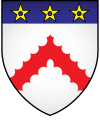 | Argent, a chevron engrailed gules, on a chief azure three mullets pierced or. |  | |
| Kellogg College | 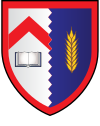 | Per pale indented argent and azure on the argent a chevron enhanced gules in base a book azure leaved argent on the azure an ear of wheat palewise or the whole within a bordure gules. |  Christ Church Boat Club[61] | |
| Lady Margaret Hall | 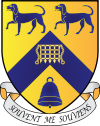 | Or, on a chevron between in chief two talbots passant and in base a bell all azure, a portcullis of the field. |  | |
| Linacre College | 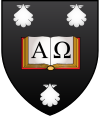 | Sable an open Book proper edged or bound gules the dexter page charged with the Greek letter alpha the sinister page charged with the Greek letter omega both sable the whole between three escallops argent. |  | |
| Lincoln College |  | Tierced per pale: (1) Barry of six argent and azure, in chief three lozenges gules, on the second bar of an argent a mullet pierced sable; (2) Argent, thereon an escutcheon of the arms of the See of Lincoln (i.e., Gules, two lions passant guardant or, on a chief azure the Blessed Virgin Mary ducally crowned seated on a throne issuant from the chief, on her dexter arm the infant Jesus and holding in her sinister hand a sceptre, all gold; the escutcheon ensigned with a mitre azure garnished and stringed or); (3) Vert, three stags trippant argent attired or.[b] |  | |
| Magdalen College | 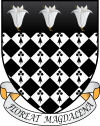 | Lozengy ermine and sable, on a chief of the second three lilies argent slipped and seeded or. |  | |
| Mansfield College | 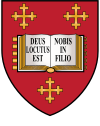 | Gules an open book proper inscribed DEUS LOCUTUS EST NOBIS IN FILIO in letters sable bound argent edged and clasped or between three cross crosslets or. |  | |
| Merton College | 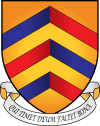 | Or, three chevronels party per pale, the first and third azure and gules, the second gules and azure. |  | |
| New College | 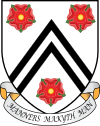 | Argent, two chevronels sable between three roses gules, seeded or, barbed vert. |  | |
| Nuffield College | 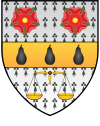 | Ermine on a fesse or between in chief two roses gules barbed and seeded proper and in base a balance of the second three pears sable, and for crest on a wreath or and gules a demi bull gules armed and unguled or resting the sinister hoof on a winged wheel or.[c] | ||
| Oriel College |  | Gules, three lions passant guardant in pale or within a bordure engrailed argent. |  | |
| Pembroke College | 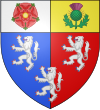 | Per pale azure and gules, three lions rampant, two and one, argent, on a chief per pale argent and or, in the first a rose gules, seeded or, barbed vert in the second a thistle of Scotland proper. |  | |
| The Queen's College | 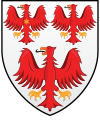 | Argent, three eagles displayed two and one gules, legged and beaked or, on the breast of the first eagle, a pierced mullet of the third as cadency mark.[d] |  | |
| Somerville College |  | Argent, three mullets in chevron reversed gules, between six crosses crosslet fitched sable. |  | |
| St Anne's College | 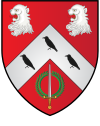 | Gules, on a chevron between in chief two lions' heads erased argent, and in base a sword of the second pummelled and kilt or and enfiled with a wreath of laurel proper, three ravens. |  | |
| St Antony's College | 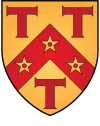 | Or on a chevron between three tau crosses gules as many pierced mullets of the field. |  | |
| St Catherine's College |  | Sable a saltire ermine between four Catherine wheels or. |  | |
| St Cross College |  | Argent a cross potent purpure a quarter counterchanged. | ||
| St Edmund Hall | 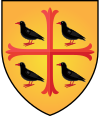 | Or, a cross patonce gules cantoned by four Cornish choughs proper. |  | |
| St Hilda's College |  | Azure on a fess or between in chief two unicorns' heads couped and in base a coiled serpent argent three estoiles gules. |  | |
| St Hugh's College |  | Azure a saltire ermine between four fleurs-de-lis or. |  | |
| St John's College | 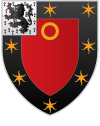 | Gules, on a bordure sable eight estoiles or; on a canton ermine a lion rampant of the second; on the fess point an annulet of the third. | ||
| St Peter's College | 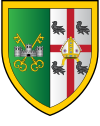 | Per pale vert and argent, to the dexter two keys in saltire or surmounted by a triple towered castle argent masoned sable (representing Oxford bailey) and on the sinister a cross gules surmounted by a mitre or between four martlets sable (for Chavasse), the whole within a bordure or. |  | |
| Trinity College |  | Party per pale or and azure, on a chevron between three griffins heads erased four fleurs-de-lys, all counter-changed of the field. |  | |
| University College |  | Azure, a cross patonce between five martlets or. |  | |
| Wadham College | 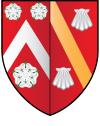 | Gules, a chevron between 3 roses argent, seeded or, barbed vert, impaling gules, a bend or between two escallops argent. |  | |
| Wolfson College | 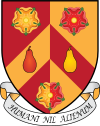 | Per pale gules and or on a chevron between three roses two pears all countercharged the roses barbed and seeded proper. |  | |
| Worcester College | 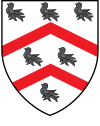 | Argent, two chevronels between six martlets, three, two and one gules.[e] |  | |
| Blackfriars | 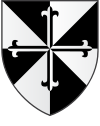 | Gyronny of sable and argent, a cross flory counterchanged.[f] | ||
| Campion Hall | 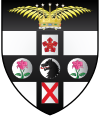 | Argent on a cross sable a plate charged with a wolf's head erased of the second between in pale two billets of the field that in chief charged with a cinquefoil and that in base with a saltire gules and in fesse as many plates each charged with a campion flower leaved and slipped proper on a chief also of the second two branches of palm in saltire enfiled with a celestial crown or.[62][g] | ||
| Regent's Park College | 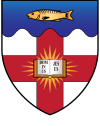 | Argent on a cross gules an open Bible proper irradiated or the pages inscribed with the words DOMINUS JESUS in letters sable on a chief wavy azure fish or. |  | |
| St Stephen's House |  | Per chevron Gules and Sable in chief two Cross crosslets and in base a Celestial Crown Or.[63][h] | ||
| Wycliffe Hall | 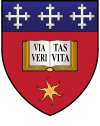 | Gules, an open book proper the pages inscribed with the words VIA VERITAS VITA in letters sable on a chief azure three crosses crosslet argent and in base an estoile or.[i] |
Notes
Heads of Houses
The senior member of each college is an officer known generically as the Head of House. Their specific title varies from college to college as indicated in the list below. While the Head of House will usually be an academic, it is not uncommon for a person to be appointed who has had a distinguished career outside academic circles.
For a list of current Heads of Houses, see Heads of Houses.
- Principal: Brasenose, Green Templeton, Harris Manchester, Hertford, Jesus College, Lady Margaret Hall, Linacre, Mansfield, St Anne's, St Edmund Hall, St Hilda's, St Hugh's, Somerville, Regent's Park, St Stephen's House, and Wycliffe Hall
- Master: Balliol, Pembroke, St Catherine's, St Cross, St Peter's, University College, and Campion Hall
- Warden: All Souls, Keble, Merton, New College, Nuffield, St Antony's, and Wadham.
- President: Corpus Christi, Kellogg, Magdalen, Reuben, St John's, Trinity, and Wolfson
- Provost: Oriel, The Queen's College, and Worcester
- Rector: Exeter and Lincoln
- Dean: Christ Church
- Regent: Blackfriars
The dean of Christ Church is head of both the college and the cathedral. The president of Kellogg College is also the director of the Department for Continuing Education.
Finances
As of 2019 the accounts of the Oxford colleges included total assets of £6.6 billion.[57] This figure does not reflect all the assets held by the colleges as their accounts do not include the cost or value of many of their main sites or heritage assets such as works of art or libraries.[64] The total endowments of the colleges were £5.1 billion as of 2019.[57] Individual college endowments ranged from £1.2m (Green Templeton) to £577.6 million (Christ Church).[27][24]
Academic rankings
For some years, an unofficial ranking of undergraduate colleges by performance in Final Honour Schools examinations, known as the Norrington Table, was published annually. As the table only took into account the examination results for the year of publication, college rankings could fluctuate considerably.
Beginning in 2005, the University of Oxford started publishing a list of colleges classified by a "Norrington Score", effectively replicating the Norrington Table. The university claims to have published the results "in the interests of openness". Although the university says that the college listings are "not very significant", the 2005 table was the first Norrington Table with official data and also probably the first to be accurate. Dame Fiona Caldicott, the Chairman of the Conference of Colleges, said that in previous years some students had used the Data Protection Act 1998 to ensure their results were not published, rendering the unofficial tables inaccurate.[65]
College rivalries
A tradition of the university is a friendly rivalry between colleges. Often, two neighbouring colleges will be rivals, and each college will pride itself in its athletic victories over the other one. Examples include:
Architectural influence
The Oxford and Cambridge colleges have served as an architectural inspiration for Collegiate Gothic Architecture, used by a number of American universities including Princeton University and Washington University in St. Louis since the late nineteenth century.[74][75]
